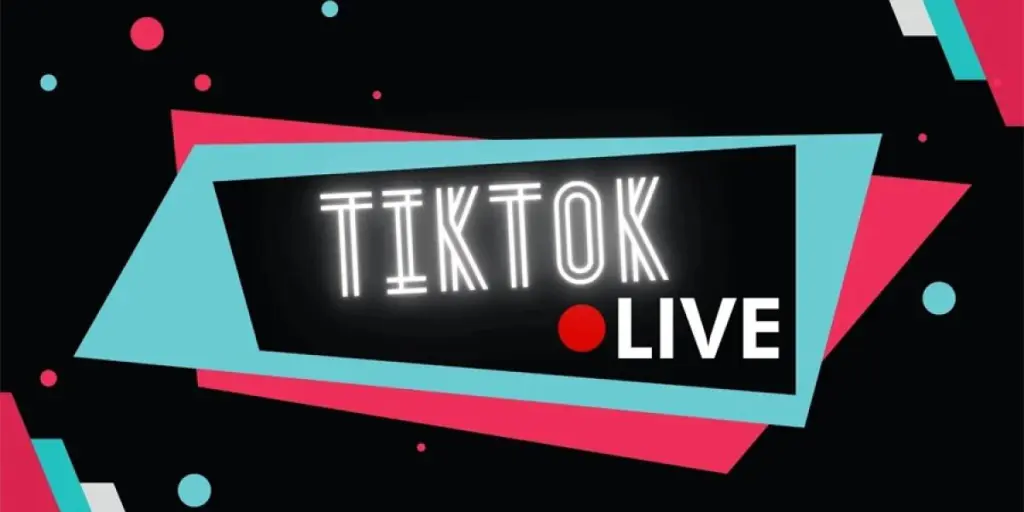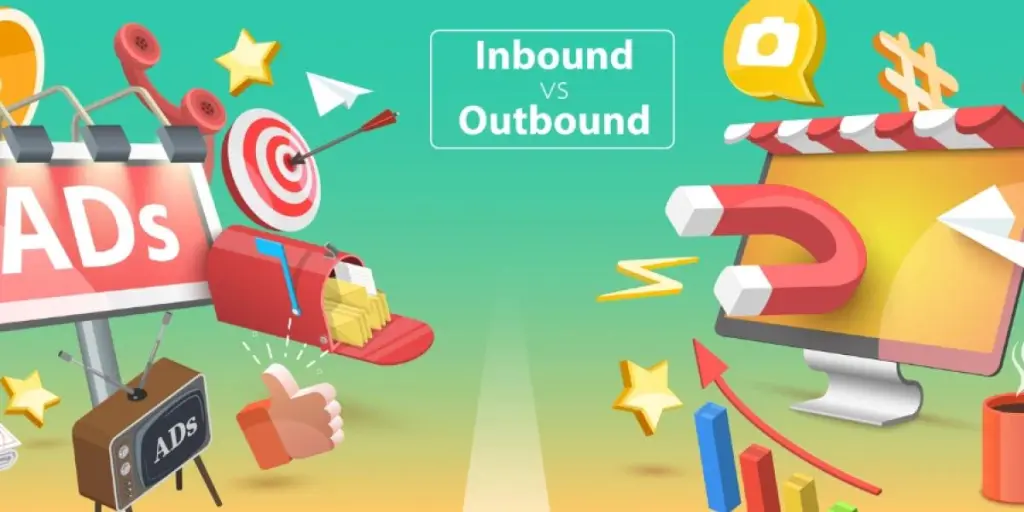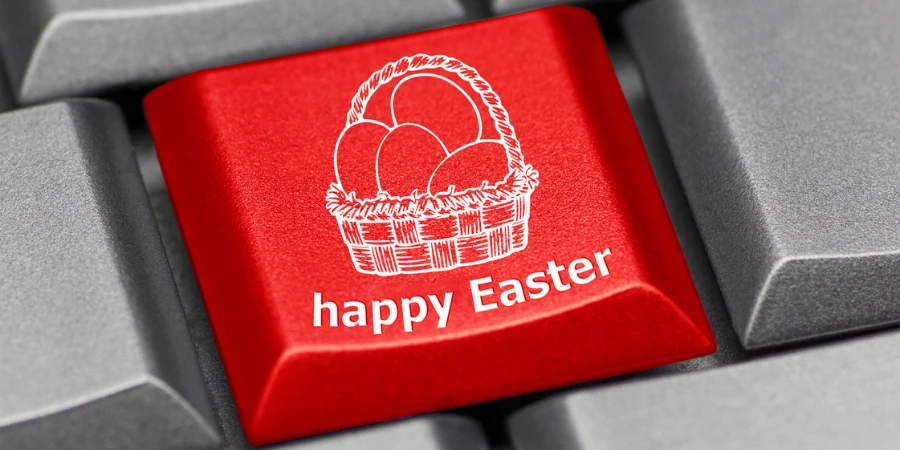Reactivation emails are often the final attempt to re-engage inactive customers. A reactivation email is a proactive marketing strategy. It helps engage and reignite dormant customers’ interest.
In this article, we’ll look in more detail at what a reactivation email is. We’ll explore some of the best reactivation email examples to inspire you to draft a successful reactivation email. And we’ll share expert insights on the best practices for sending reactivation emails.
Let’s get started.
What is a reactivation email?
A reactivation email is designed to re-engage inactive subscribers. These may be people who have stopped opening your messages, or former customers who haven’t purchased in a while.
A reactivation email is also known as a win-back email. It aims to spark interest and persuade the recipient to open your emails and/or buy from you again.
Thus, reactivation emails are crucial for retaining and rekindling valuable relationships.
Is it worth sending reactivation emails?
Sending a reactivation email to inactive subscribers helps businesses sustain their customer base. Here are some of the benefits of reactivation emails for businesses:
- Improved engagement rates. A compelling reactivation email can encourage your subscribers to engage with your content.
- A healthier and more responsive list. These emails target users who haven’t engaged in a while, encouraging them to engage or identifying ways for you to clean your list.
- New opportunities for sales and lead generation. Customer reactivation emails remind customers of your products or services, increasing the likelihood of a sale or subscription.
- Reinforce brand recognition and affinity with past contacts. This strengthens your prospect pool for marketing campaigns.
Best practices for sending reactivation emails
Sending reactivation emails to inactive customers is a powerful tactic to reignite relationships. However, reactivation emails must be strategic for them to be effective.
Here are some reactivation email marketing best practices to follow:
- Personalize the subject line and email content to capture the recipient’s attention. Generic messages are more likely to be ignored. Address the customer by their name and use their previous purchases to recommend products that might interest them.
- Remind the customer of their last purchase date, items purchased, or total spent. Mentioning specific details can trigger memories and make them feel valued. For example, your email could say, “It’s been 8 months since you treated yourself to (product name).”
- Offer an incentive to reactivate their account and make a purchase, like a discount code, gift, or free shipping.
- Maintain a positive tone. Avoid desperate pleas or messaging that could be interpreted as guilt-tripping.
- Divide inactive users into groups based on prior interactions with your products or services. Create customized reactivation emails for different customer lifecycle categories. Customer lifecycle segmentation can help you send timely messages to your customers.
- Test different messaging, incentives, and designs before full-scale deployment. This helps you determine the best approach to engage your inactive customers.
- Keep your reactivation emails at a reasonable frequency. Too many emails can be seen as spam, while too few may be ineffective.
To ensure timely communication, and reduce your workload, you can use triggers to automatically send customer reactivation emails.
10 great reactivation email examples
Great reactivation emails aren’t just attention grabbers — they also motivate recipients to act and rediscover the value of your brand, product, or service.
We’ve compiled a list of 10 stellar examples to inspire your reactivation emails:
1. Special offer emails
Special offer emails encourage action via incentives such as discounts or promotions
Check out these examples of special offer reactivation emails below:
Youtube
Subject line: Enjoy $50 off NFL Sunday ticket with YouTube TV
YouTube cleverly combines a discount with the appeal of a major sporting event to entice previous subscribers to return.
The email has a clean, visually appealing layout. It draws attention with a contrasting blue button that displays the call-to-action “Reactivate now” that encourages immediate engagement.
The content is concise and clearly emphasizes the benefits of signing up. It’s easy for recipients to understand the value proposition at a glance.

Skillshare
Subject line: Come see what’s new!
This subject line uses curiosity to grab the recipient’s attention and spark interest in the new offer.
The simple design and clear information hierarchy direct the reader’s attention. The CTA is bold, clear, and has a compelling offer of getting a month’s access for only $0.99.
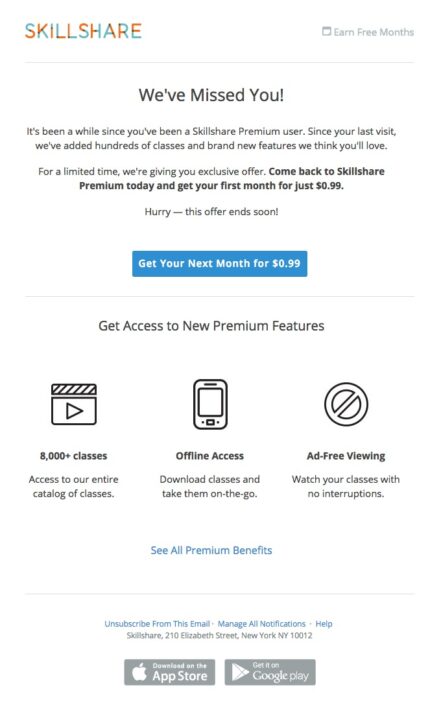
2. Request for feedback emails
These emails ask for comments from customers on their previous interactions. The intent is to discover areas for improvement while re-engaging the receiver.
Check out some top examples of email feedback requests:
Lonely Planet
Subject line: Help Lonely Planet map our next chapter 🗺️
This is a great example of a reactivation email. Lonely Planet goes all in to rekindle the recipient’s interest in the brand by asking them to contribute their opinions.
The email is clear and concise, and explains that feedback is collected in just 2 minutes — highlighting that the reader isn’t required to sacrifice a lot of time.
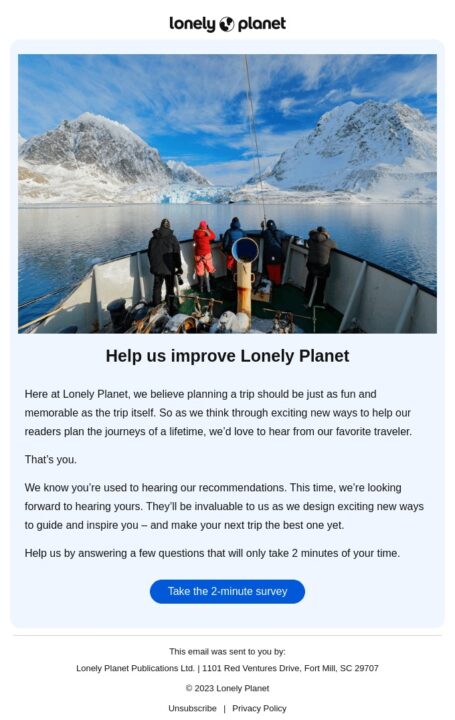
Miro
Subject line: Share your experience with us
Miro’s reactivation email uses a friendly and inviting tone to encourage recipients to share feedback.
The subject line is clear, and the email content is very short and concise. As with Lonely Planet, the email also states how much time is required to share the feedback (in this case, 5 minutes).
This helps to remove any friction. Also notice that the email doesn’t bombard the reader with lots of questions or information.
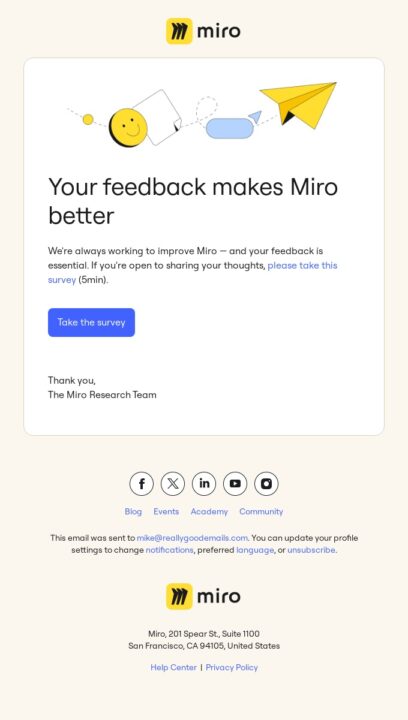
3. New features emails
These emails notify subscribers of the company’s new service or product features. They’re a great marketing tactic because they generate interest and excitement while encouraging re-engagement with the brand.
Here are some examples of emails informing customers of new features:
Venmo
Subject line: Smiles Davis, getting back into Venmo? Here’s a refresher.
This reactivation email example by Venmo instantly states the new features to get the user’s attention.
It then highlights specific new features, such as cashback and touch-free payment. It also states significant improvements and motivates subscribers to explore the updates.
The email ends with an invitation to explore Venmo’s possibilities and see what the app can do for you.

Asana
Subject line: Since you’ve been gone…
Asana doesn’t waste any time in this email to tell readers that the platform is now twice as fast as the last time the user logged in.
There’s a clever visual of someone running — conveying speed — and a simple CTA encouraging readers to visit Asana again.
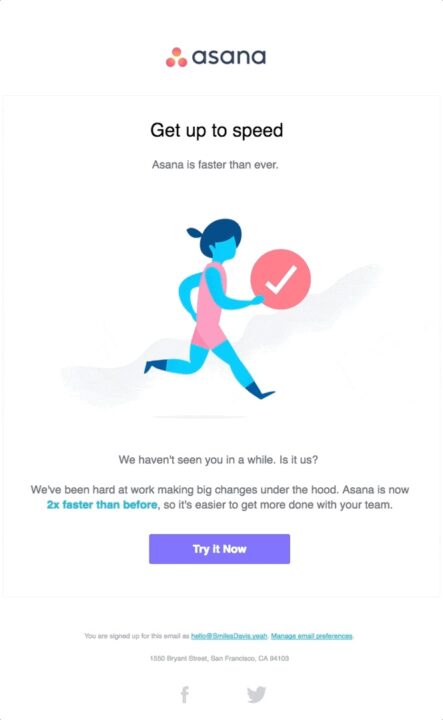
4. “We missed you” emails
“We missed you” emails portray a sense of loss and urge inactive subscribers to return. Here are a couple of strong examples of this type of email:
Typeform
Subject line: We haven’t seen you in a while.. 🙁
The email stands out for its emotive language. First, the subject line emoticon adds a personal touch and makes the communication feel more human.
The content of the email maintains a friendly and lighthearted approach. This email also presents subscribers with a clear path for re-engagement. The email content and CTA encourage subscribers to explore new ideas they may have missed, while showcasing Typeform’s new templates.
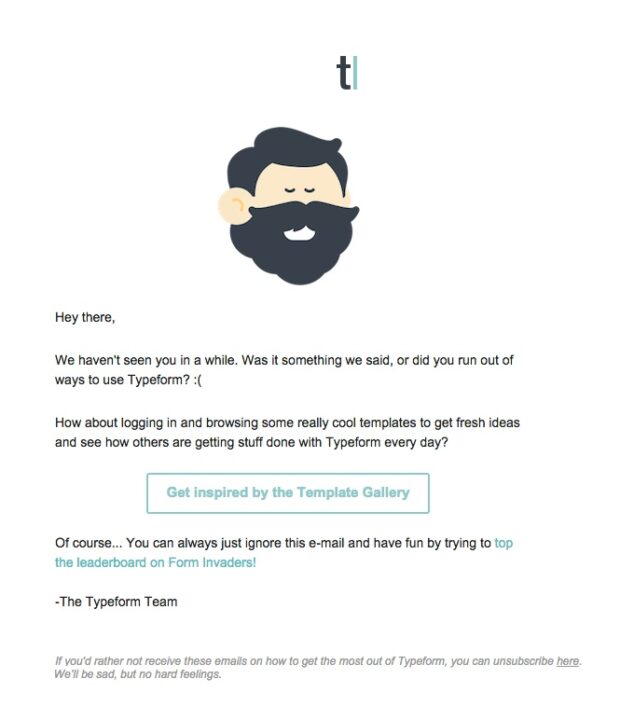
Duolingo
Duolingo has an excellent reactivation campaign for its.
First, the subject line, “We miss you!” creates a personal connection and makes the receiver feel valued.
The email itself is extremely short and direct, and speaks to the reader’s ambitions. It asks if they still want to learn a new language and offers a 5-minute lesson. The CTA offers to help them “get back on track” — this is clever because when we get off track, it’s common for people to give up entirely.
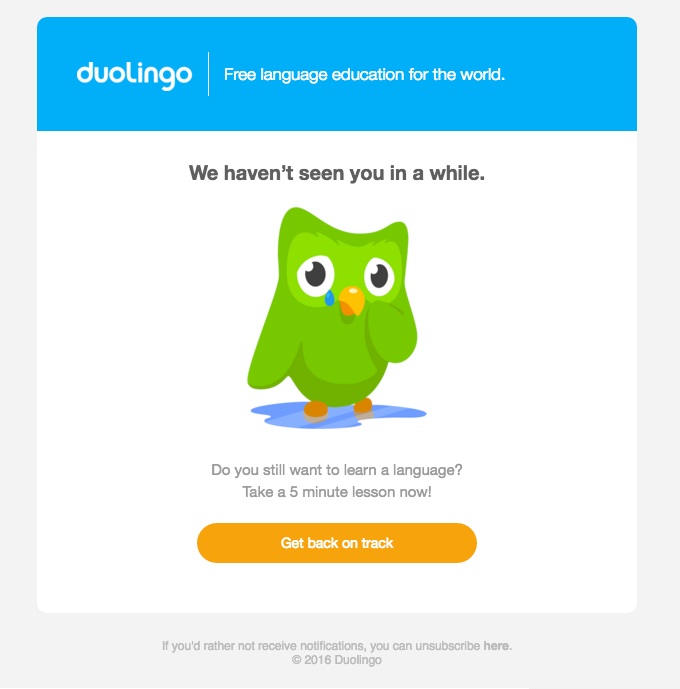
5. Unsubscribe emails
These emails help you to clean your list by removing subscribers, or suggesting they unsubscribe if they no longer want to hear from you. Although your list size may reduce, you should see an increase in engagement.
Here are two great examples of unsubscribe emails:
Cuisinart
Subject line: Pssst…we have a question for you.
This email from Cuisinart gives readers a choice: to stay subscribed, or not. For those who choose to stay, it’s likely that they’ll begin to engage more with future emails.
The dual call-to-action buttons — “Stay” and “Leave” — give clear options. This makes it easy for the user to choose between receiving emails or unsubscribing from the email list.
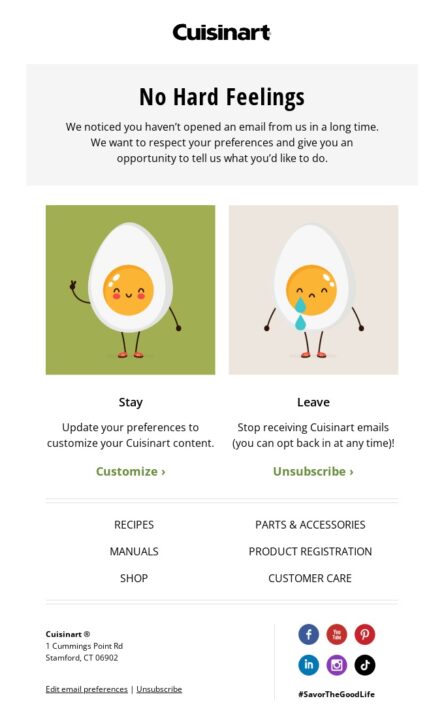
Readymag
Subject line: You’ll be unsubscribed from Readymag emails
Readymag takes a different approach to Cuisinart, by offering essentially an ultimatum: click the link to stay subscribed or be removed from the contact list.
The email copy is short and direct, and there are strong visuals with a large red cross, black circle stating they haven’t opened recent emails, and a red CTA button.
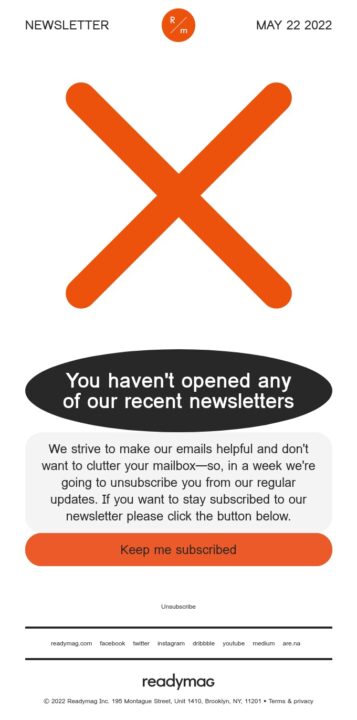
Wrap up
As you consider boosting engagement in 2024, focus on reconnecting with inactive contacts. Reactivation emails are a powerful tool for this.
The above examples highlight how versatile these emails can be, and should inspire you in creating your own to the specific context of your business.
Source from Omnisend
Disclaimer: The information set forth above is provided by omnisend.com independently of Alibaba.com. Alibaba.com makes no representation and warranties as to the quality and reliability of the seller and products.


